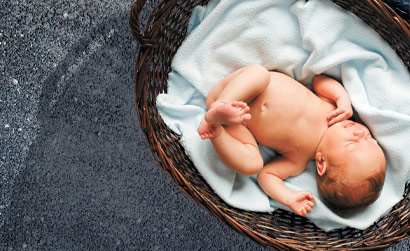

Saving Grace: Lifelong Wantagh resident and AMT Children of Hope/Baby Safe Haven President Timothy Jaccard kneels before the graves of several newborns he buried at Holy Rood Cemetery's Island of Hope in Westbury. The children were discovered abandoned, the victims of homicide. (Ethan Stokes/Long Island Press)
Matthew Hope rests here, a newborn found amid the garbage at Nassau County’s Bay Park Sewage Treatment Plant. Faith Hope sleeps nearby, found in a shallow grave in Freeport. So do Jonathan and another Matthew Hope, discovered half an hour apart on opposite sides of the Williamsburg Bridge. More than 1,500 people attended their ceremony and funeral, with services held in St. Patrick’s Cathedral prior to their transport to Holy Rood.
Jaccard makes the arrangements for each funeral with Charles J. O’Shea Funeral Home, which provides all of the services for free and absorbs most of the burial’s cost, he says. Prior to the service, he dresses each child in a baptismal gown, especially made for them by the New York/Long Island chapter of Huntington Bays-based nonprofit Newborns In Need. He affixes a Heart of Hope pin on its lapel bearing a heart surrounded by four teardrops. He says a prayer before the coffin is closed. He literally places the baby in the grave once the ceremony is finished and finally, covers the grave with dirt.
As tragic as these deaths are, each funeral helps the group come closer to its overall objective of preventing another, explains Adoption Home Study Specialist Caren Sue Peet, L.M.S.W, one of AMT Children of Hope’s veteran volunteers—through raising awareness about the issue and the existence of the Safe Haven program.
In this way, Thomas John’s death prevented the deaths of others, she believes.
“We saved 12 babies that we know of since he was found,” Peet tells the Press. “Because of his story that got people’s attention, so many newborns were found. So, in a way, what we like to say is that all the newborns who are found are heroes, because through their deaths, other babies are saved.”
Ditto for the Winters Brothers employees who discovered the child, she explains—people she has since come to know and speak with frequently. After the tragedy, Peet says she posted about it on her Facebook page. A friend of her friend saw the post and inquired about contacting Peet. Soon enough, she was having constant conversations with the supervisor of the Yaphank facility.
“The man who found him didn’t speak much English. Of course, he was devastated. He was sorting garbage, and he found parts of a baby,” she recalls. “Every time a baby is saved I tell him to tell the worker that another baby was found because of him. Because if he hadn’t found Thomas, then other babies might not have been saved. So every time a baby is saved, it is because of this worker.”
It’s getting the word out that is the most difficult obstacle, says Peet.
“People don’t know it exists, that’s the biggest problem, that people don’t know it exists,” she continues. “Call us and we’ll help you.
 “When you have to go to a funeral like that, when you know the birth mother had a choice and maybe just didn’t know that she could call us, it’s beyond heart wrenching,” she adds. “The coffin is the size of a shoe box.”
“When you have to go to a funeral like that, when you know the birth mother had a choice and maybe just didn’t know that she could call us, it’s beyond heart wrenching,” she adds. “The coffin is the size of a shoe box.”
When AMT Children of Hope/Baby Safe Haven is informed of the death of a newborn, they get the health proxy for that child. They then ensure that each and every newborn is laid to rest with dignity, love and honor.
Yet AMT Children of Hope/Baby Safe Haven does much, much more than bury children who have been left for dead.
Send Me An Angel
On Good Friday, this year, Jaccard was having one of what he describes as a rare breakfast with his wife when the Safe Haven crisis center in Ohio contacted him. They had a woman in labor on the telephone. The call was transferred to Jaccard, who had done five previous telephone births. Within an hour and a half, the labor would be over and the baby born.
The birth mother put her telephone on speaker, and Jaccard talked her through the birthing process. He directed her to get towels, sheets and some string to tie off the umbilical cord, all the while trying to convince her to get some help. She continued to refuse. Jaccard then described how she could tell if she was crowning. She said she felt the baby’s head, and he told her to start pushing. After the third heavy contraction, the baby was born.
Following Jaccard’s directions for cutting the cord, the mother then cleared the baby’s mouth with her finger, and the baby started crying “loud and clear.”
Jaccard was elated.
“I explained to her to put the baby in the towel and keep him warm, and then she had to deliver the placenta next,” he says. “After 15 minutes, the mother expelled the placenta, and described it to me in full detail. This is done to see if any tears or any materials were still left inside of her.”
The birth mother then rested for about 25 minutes, all the time keeping in telephone contact with Jaccard, who kept trying to convince her to let him have someone come and care for her. The mother kept refusing, and after Jaccard was convinced it was safe for her, she agreed to get into her car and bring the baby to a local hospital. Meanwhile, Jaccard had to inform the staff at the hospital as to the details and requirements of the law.
Soon after, the mother arrived at the hospital and the baby was handed over to the medical staff.
Despite his pleas, the mother refused to stay. She did agree to keep in contact with Jaccard, and called him back every hour for the first six hours. She also called on Saturday and Sunday mornings and told him she was sore but doing well. She agreed to take vitamins but would not take an antibiotic.
On Easter Sunday, Jaccard took another call. This time the mother had already given birth. She agreed to leave the baby at a local church.
 When the weekend was over, Jaccard knew his battle that had started years ago was one worth fighting. He had saved two more infants’ lives.
When the weekend was over, Jaccard knew his battle that had started years ago was one worth fighting. He had saved two more infants’ lives.
The McCann family knows firsthand about rescued children.
Donna McCann had tried for seven years to have a baby. She lived in a world that only those who can’t conceive can really understand; her life was filled with constant pain and longing. When she would see a pregnant woman or a baby, the pain would surface, along with a feeling of jealousy. When she went to baby showers, she would excuse herself and go into the bathroom and cry. Her husband, Tom, was also dealing with his own pain, but, Donna says, “I think I showed it more.”
After seven long and emotionally devastating years, the McCanns tried to adopt, but, despite their hopes, they would not succeed at that, either. Then they met Jaccard. Because of him, Donna says their constant pain is gone and, “Our lives are now complete.”
Since volunteering with AMT Children of Hope/Safe Haven, she has adopted a young boy and girl through the program.
“We feel so complete now,” she says. “Finally it feels like there is no heaviness on my shoulders and there is no ache in my heart. Now, we are the perfect family.”
Children of Hope/Baby Safe Haven does not do adoptions, stresses Jaccard—it strictly handles the rescuing aspects of such cases. The group can, however, inform the parents about licensed adoption agencies and notify those agencies, who would then carry the process through.



